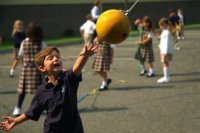To Improve School Climate, Examine Recess
As we look at ways to create environments that allow teaching and learning to thrive, it's time to take a long, hard look at the critical role of recess in our schools. Recess has the potential to transform schools, and groups are finally speaking out about the powerful role it has in the school day, including the American Academy of Pediatrics which, earlier this year, released a policy statement to this effect.
Proven Benefits
More and more research underscores the invaluable and positive impact recess can have on teaching and learning. In early 2009, researcher Romina Barros of Einstein College found that third grade students who had at least 15 minutes of recess every day behaved better in the classroom than their peers who did not get daily recess.
A safe and healthy recess has tremendous potential, not only to get our children more physically active, but also to support social and emotional learning, preempt bullying and develop the invaluable "soft skills" our kids need to become thriving adults. Through play, students learn teamwork, cooperation, empathy and more.
The Collaborative for Academic, Social and Emotional Learning (CASEL) underscores the benefits of learning these critical skills. Students who receive social-emotional learning instruction, such as teaching skills for safe and inclusive play at recess, have more positive attitudes in school and improved academic achievement.
Recently, Mathematica Policy Research and Stanford University's John Gardner Center released the results of a randomized control study which found that investing in recess and organized play can prevent bullying, improve students' behavior at recess and their readiness for class, and provide more time for teaching and learning.
Developing a safe and healthy recess may take time, but the effort is clearly worth it to develop students who are not only more physically active, but also have improved social and emotional skills, feel that they're a more connected part of the community, experience less bullying and exclusionary behavior and receive more class time.
Five Steps to a Recess-Friendly Playground
To create a healthy recess, begin by taking a step back and examining the schoolyard. Take an in-depth look at what is working and what is not. With a team of teachers, staff, parent volunteers and student leaders, ask yourself the hard questions. How much time do kids get to play? How do students transition to and from the playground? Where do the students play? What equipment is available and what games do they play?
Once you have examined recess, work together to create a space for safe, fun and inclusive play. You may want to start with these five steps:
1. Map the Playground
Determine the students' favorite games and develop a map that provides safe boundaries for play. Create a safe place for ball games where balls aren't kicked or thrown into other games. Allow space for low-key forms of play, such as skipping rope, pretend play and hopscotch. Find a space for an equipment check out/in to ensure that balls and ropes aren't lost. And include space to lead and play new games.
2. Go Play!
When adults model behaviors of respect and inclusion on playground, students feel safe and encouraged to do the same. If you miss the ball in 4-Square, quickly jump back in line with a smile. When you score a basket sending another player to the line, give them a high five and say, "Nice try." It's important not only to model respectful behavior, but also to hold students accountable for meeting the same expectations of positive and inclusive behavior.
3. Teach Fun and Simple Games
When possible, teach students new games in small groups. Games introduce new skills and level the playing field for children whose physical activity skills vary greatly. Great games are rotational, have minimal "out" time and allow children to always have a role in the play. Some of my favorites include Switch, Bandaid Tag and Three Lines Basketball.
4. Teach Conflict Resolution Skills
Teach students Rock Paper Scissors (also known as roshambo) and other conflict resolution techniques. When we teach students to solve their own conflicts, we empower them and make recess (and the class time following recess) much more enjoyable. We see firsthand that when students use Rock Paper Scissors, they quickly resolve the majority of simple playground conflicts. "Was the ball in or out?" Rock Paper Scissors. "Who got in line first?" Rock Paper Scissors.
5. Teach Positive Messages
Encourage positive behavior through high fives and positive language. Acknowledge students' effort by giving a high five, a fist bump or saying something kind, such as, "Good job," or "I like how fast you ran!" each time they participate. Encourage the other students to also pass out high fives and say, "Nice try."
Recess is much more than simply fun and games. When you take the time to examine recess, to build a healthy culture of play where the bullying is reduced, and to give kids a sense of ownership, this fundamentally changes their attitudes about school. And as we look at ways to support our schools and students, this one is worth the long, hard look.
